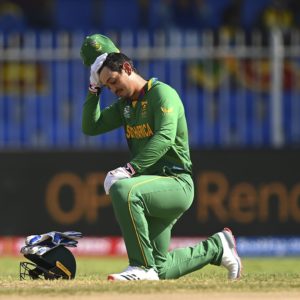Lizelle Lee is a cricketing powerhouse
The 2021 ODI Women’s Cricketer of the Year has honed her batting skills all the way to the top of the order and she’s ready to lead the Proteas to World Cup triumph.
Author:
3 March 2022

South Africa’s Proteas find themselves in an unfamiliar position heading into the 50-over World Cup in New Zealand. For the first time in 14 global tournaments, they harbour realistic ambitions of lifting the trophy.
“We wouldn’t be going if we didn’t all believe we could actually do it,” says Lizelle Lee, the team’s destructive opening batter who was recently recognised as the best 50-over player in the world by the International Cricket Council (ICC). “We spoke about this in camp. We all agreed that there was no point in going if we didn’t intend to come back as champions. We know it’s never been done before, but we want to make history as the first South African team to win a World Cup.”
South Africans have conquered the world before. The men’s Under-19 team, captained by Aiden Markram and coached by Ray Jennings, in 2014 became the first side to win a major final. But no senior squad has done it.
This group is unburdened by a history of failing when it mattered. The South African women’s side, under-resourced in every metric compared with their male counterparts, have long fought for equality in the country’s third most popular sport. All too often they’ve been regarded as an afterthought, contesting untelevised games in near-empty stadiums.
Related article:
“When I was growing up, I didn’t even know there was a South African women’s team,” says Lee, who grew up in the agricultural and mining town of Ermelo, Mpumalanga, and will be 30 in April. “It just wasn’t something I was conscious of and I know a lot of other girls will tell you the same thing. It wasn’t on TV. You didn’t see games advertised. I played because I loved the game. I didn’t play for fame or money or recognition.”
The dial shifted in 2013 when insurance firm Momentum joined as a title sponsor and helped Cricket South Africa (CSA) fund full-time contracts for six players. That number increased over the years – there are currently 15 centrally contracted players with CSA – but changes in other facets have been slow. The team was constantly playing catch-up with the more advanced cricket ecosystems in Australia and England, which together have won 16 of the 18 global showpieces since 1973.
“Those countries are so far ahead,” says Lee, who has been a mainstay in the Australian Women’s Big Bash League, and has played for Somerset and Surrey in England. “Women players are given a much bigger platform there. I’m more recognised when I walk around there than I am in South Africa. But it is changing.”
No longer amateurs
Lee credits CSA for “promoting the women’s game” but the players have advanced their own cause on the field. By the time the T20 World Cup in Australia came into focus in January 2020, Lee could look around a dressing room studded with match-winners.
“It’s not that it happened all of a sudden, because we’d been working hard for a few years,” she says. “But now we have superstars all around, genuine world-class players.”
There was captain and leg-spinning allrounder Dane van Niekerk. Shabnim Ismail, the fastest and most aggressive female bowler on the planet. Laura Wolvaardt, arguably the most graceful batter of any gender. Seamer Ayabonga Khaka, hard-hitting Chloe Tyron, experienced Mignon du Preez… With coach Hilton Moreeng in charge since 2012, this is no longer a small outfit with an outside chance of causing an upset. The glass ceiling has become a door to another level for this well-drilled and confident unit.
Having won just two of their previous 18 Twenty20 meetings with England, South Africa edged a thriller by six wickets with two balls remaining in their tournament opener in Perth. Khaka’s 3/25 reduced England to 123/8 and Van Niekerk’s 46 set up a thrilling chase.
Related article:
“That win gave us belief,” Lee says. “I remember the feeling afterwards. We were so happy and were celebrating. But Dane told us that we had only won one game. She didn’t let us get carried away. We had bigger things we wanted to achieve.”
They swept Thailand by a margin of 113 runs and Pakistan by 13. When the match against the West Indies was abandoned without a ball being bowled, they topped the group. But the rain that proved helpful contributed to their downfall in the semifinals. After restricting the Australians to an attainable 134/5, the Sydney skies opened and reduced South Africa’s stay in the middle to 13 overs. A revised target of 98 was just out of reach. Despite Wolvaardt’s majestic 42 from 27 balls, South Africa’s women tasted the same bitterness that the men’s team have been chewing on since 1992.
“It hurt,” remembers Lee. “It hurt because we lost but also because we felt like we could have won it. That’s crazy when you think about it, because we were playing Australia at home. We’d never beaten them in a T20 before and to even think that the weather impacted us means that we were competing. We took that hurt and haven’t forgotten it. We now know we can beat anyone on our day.”
In top form, untouchable
That is especially true when Lee is at her destructive best. And for much of the past 18 months, she has been. Her last knock before a bout of mild Covid-19 saw her notch 61 runs in a one-day international (ODI) against the West Indies in Antigua in September. The week before, she registered an unbeaten 78. A few days before that, she hit a match-winning 91 not out.
During the English summer at the inaugural Hundred competition last year, she hit the first boundary of any batter – man or woman – and ended with an average of 43 as Manchester Originals’ highest scorer.
“She’s a phenomenal talent and well deserving of her personal award,” says Paul Shaw, Lee’s head coach at the Originals. “She stands out from almost every other female player in the game in that she can consistently clear the ropes. Her power game is astonishing. Any team in the world would be lucky to have her at the top of the order.”
Related article:
Shaw first encountered Lee when he was head coach of England for South Africa’s tour of the country in 2014. Her reputation preceded her, but he felt that her game was at times one-dimensional, that her innings only went in one direction until she was dismissed.
“That’s definitely something that I’ve learned to develop,” Lee says. “When I was younger, I’d only look for the boundary ball and that’s the worst thing you can do when batting. Now I look for the single. That’s my first aim. To get off strike and keep things moving. I back myself to react and put the bad ball away or, if it’s in the slot, to lean back and hit it for six. It’s a mindset. If I get bogged down, I can rebuild if necessary. I think that’s what’s been the most crucial thing behind my development.”
Among the best
The numbers prove that something has shifted for Lee. Her strike rate of 79 in ODIs last year was her lowest since 2015 but she averaged 90.28, scoring 632 runs in 11 matches. As if to prove this recalibration hasn’t stifled her explosive nature, she bludgeoned five half-centuries and 132 not out against India in Lucknow.
By winning the ICC ODI’s Women’s Cricketer of the Year award for 2021, she joins an elite list that includes all-time greats Stefanie Taylor of the West Indies, England’s Sarah Taylor, New Zealand’s Suzie Bates and Australian duo Meg Lanning and Ellyse Perry.
“I’m not surprised she’s among those names,” Shaw says with pride. “When you look at what she has, she has every chance of going down in history as one of the best openers the game has seen. No bowler in the world would fancy bowling to her when she’s in the mood. She’ll be the biggest prize for any bowling unit at the World Cup.”
Related article:
Lee is unperturbed. “There’s always going to be pressure, especially when playing on such a big stage,” she says. “But we’re relaxed. We don’t have a mental skills coach or anything like that. We had one a while ago. We didn’t find that it worked for us. We don’t like sitting in a boardroom speaking about feelings. We all know what we need to be ready. We play at our best when we’re relaxed. And we’re the most relaxed when we’re confident. It’s like one thing feeds the other thing, you know?”
That’s easy enough to understand. Cricket is a simple sport at its core. A ball is delivered. Someone with a bat 20.12m away has to hit it. And few hit it harder than Lee. She’s officially the best woman in 50-over cricket. And if she can hit enough balls with enough force, she may also be a World Cup champion.




